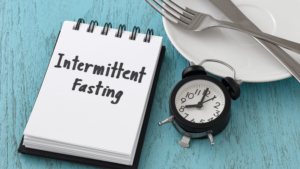
Effortlessly Achieve Your Health Goals with These Intermittent Fasting Hacks
Discover the benefits of Intermittent Fasting and learn how to hack it to fit your lifestyle with our comprehensive guide. From adjusting the fasting and eating window to combining with other healthy habits, we've got you covered. Try Intermittent Fasting Hacks today!
Effortlessly Achieve Your Health Goals with These Intermittent Fasting Hacks
Intermittent fasting is a powerful tool for achieving optimal health and fitness. Simply put, it's an eating pattern that alternates periods of eating with periods of fasting. It has gained popularity in recent years for its weight loss benefits and its ability to improve insulin sensitivity.
But for many, sticking to a strict fasting schedule can be challenging. That's where intermittent fasting hacks come in. In this article, we'll dive into the most popular methods of intermittent fasting and provide you with tips and tricks for making it a sustainable, long-term part of your routine.
From handling hunger during fasting periods to personalizing your approach, we'll show you how to make intermittent fasting work for you. Read on to discover the many benefits of intermittent fasting and how you can hack your way to optimal health and wellness.
The benefits of Intermittent Fasting Hacks
Intermittent fasting has a wide range of benefits for overall health and wellness, with weight loss and improved insulin sensitivity being two of the most well-established benefits.
Weight Loss: Intermittent fasting can help promote weight loss by creating a calorie deficit. When you fast, you consume fewer calories than you would during a normal eating period, which can lead to a reduction in body weight over time. Additionally, intermittent fasting has been shown to increase the release of the hormone norepinephrine, which helps to boost metabolism and burn more calories.
Improved Insulin Sensitivity: Intermittent fasting can also improve insulin sensitivity, which is an important factor in maintaining healthy blood sugar levels. Insulin sensitivity refers to how well your body responds to insulin, the hormone that regulates blood sugar. When your body is insulin sensitive, it is better able to clear glucose from the bloodstream, which can reduce the risk of developing diabetes. Intermittent fasting has been shown to increase insulin sensitivity by up to 31%, which may help reduce the risk of diabetes.
Other benefits: Intermittent fasting can have a positive effect on overall health, including decreased inflammation, improved heart health, and improved brain function. It may also help in extending lifespan by promoting the cellular repair process.
It's worth noting that some people may find fasting difficult and may not be able to maintain it for a long period of time. Additionally, certain medical conditions or medications may contraindicate fasting. Consulting with a healthcare professional is always a good idea before starting any sort of diet change.
Common Intermittent Fasting Methods
Intermittent fasting is a flexible approach to eating, and there are several common methods that you can choose from to suit your lifestyle and goals. The most popular methods include the 16/8 method, the 5:2 diet, and alternate-day fasting. The 16/8 method involves fasting for 16 hours and eating during an 8-hour window. The 5:2 diet involves eating normally for 5 days and fasting for 2 non-consecutive days. Alternate-day fasting is where you fast every other day. Each method has its own set of pros and cons and may be more or less suitable depending on your personal preferences, lifestyle, and health goals. In this article, we'll take a closer look at each of these methods and explore the benefits and drawbacks of each one to help you find the best method for you.
The 16/8 Method
The 16/8 method, also known as the Leangains method, is one of the most popular forms of intermittent fasting. As the name suggests, it involves fasting for 16 hours and eating during an 8-hour window. This typically means skipping breakfast and only eating during the latter part of the day.
One of the main benefits of the 16/8 method is that it is relatively easy to stick to because the fasting period is shorter than other methods, and people usually find it manageable to eat during a condensed window. It also allows for a consistent feeding schedule which could be beneficial for muscle gain or for those who workout in the morning.
Another benefit of this method is that it may help to improve insulin sensitivity, which is an important factor in maintaining healthy blood sugar levels. By reducing the number of meals consumed over a 24-hour period, insulin levels can decrease over time. This can help to improve overall health and lower the risk of developing diabetes.
To make this method work for you, it's helpful to plan your meals and snacks in advance. This will help you to stay on track and make sure you are eating enough during your eating window. It's also important to stay hydrated during the fasting period. Drinking water, herbal tea, and other low-calorie beverages can help to curb hunger and keep you feeling full.
Another important tip is to pay attention to the nutrient density of the foods you eat, and prioritize nutrient-dense food options to make sure your body is getting enough essential nutrients during the eating window.
It's important to remember that this method is not suitable for everyone and it's always a good idea to consult with a healthcare professional before starting any new eating plan.
The 5:2 Diet
The 5:2 diet is another popular form of intermittent fasting. As the name suggests, it involves eating normally for 5 days a week and then limiting calories to 500-600 for two non-consecutive days.
One of the main benefits of this method is that it is relatively easy to stick to because you are only fasting for two days a week and you are allowed to eat normally for the other five days. This can make it more sustainable than some other forms of fasting.
Another benefit of the 5:2 diet is that it can help to promote weight loss by creating a calorie deficit. By eating normally for five days and then limiting calories for two days, you are likely to consume fewer calories overall. This can lead to a reduction in body weight over time.
To make this method work for you, it's important to plan your meals in advance for your fasting days. Eating nutrient-dense foods, like vegetables and lean protein, can help to keep you feeling full and provide your body with the nutrients it needs. It's also important to drink plenty of water and other low-calorie beverages to help curb hunger.
On the non-fasting days, it's also important to make healthy food choices and not overcompensate for the fasting days, as this could defeat the purpose of the diet.
It's important to note that this method may not be suitable for everyone, especially for those with certain health conditions or those who are pregnant or breastfeeding. It's always a good idea to consult with a healthcare professional before starting any new eating plan.
Another important aspect to keep in mind is that this method requires a lot of self-control and discipline to stick with it, while it could be beneficial to some people, others may find it difficult to sustain this diet over a long period of time.
The Alternate Day Fasting
Alternate-day fasting is a form of intermittent fasting that involves fasting every other day. This means that on one day, you eat normally, and on the next, you fast by consuming only a limited number of calories, usually around 500-600.
One of the main benefits of this method is that it can promote weight loss by creating a calorie deficit. By fasting every other day, you are likely to consume fewer calories overall, which can lead to a reduction in body weight over time.
Another potential benefit of alternate-day fasting is that it can improve insulin sensitivity and help to reduce the risk of diabetes by decreasing the overall number of meals consumed over a 24-hour period.
To make this method work for you, it's important to plan your meals in advance and make sure you're getting enough nutrients on the days when you're eating. Eating nutrient-dense foods, like vegetables and lean protein, can help to keep you feeling full and provide your body with the nutrients it needs. It's also important to drink plenty of water and other low-calorie beverages to help curb hunger.
It's also important to remember that this method may not be suitable for everyone, especially for those with certain health conditions or those who are pregnant or breastfeeding. Additionally, this method requires a lot of self-control and discipline, and some people may find it difficult to stick to it over the long term. It's always a good idea to consult with a healthcare professional before starting any new eating plan.
Another thing to keep in mind is that alternate-day fasting may not be the most suitable method for those who have a highly active lifestyle or those who engage in regular intense exercise as the lack of calorie intake on fasting days might affect their performance.
The Pros and Cons of Each Method
Each of the three common methods of intermittent fasting (the 16/8 method, the 5:2 diet, and alternate day fasting) has its own set of pros and cons that may make it more or less suitable for different people, depending on their lifestyle, goals, and health.
The 16/8 method: Pros: -Relatively easy to stick to as the fasting period is shorter than other methods
- Allows for a consistent feeding schedule which could be beneficial for muscle gain or for those who work out in the morning.
- May help to improve insulin sensitivity
- Promote weight loss
Cons:
- It may be difficult to eat all of your daily calorie needs within an 8-hour window
- May be difficult for people who are not a morning person and don't feel like eating in the morning
- Some people may find the eating period too condensed and find it challenging to fit in all their daily calorie needs in that time frame.
The 5:2 diet: Pros: -Relatively easy to stick to as you only have to fast for two days a week
- Allows for normal eating for 5 days a week -Promote weight loss
Cons:
- Requires a lot of self-control and discipline to stick with it
- Fasting days can be challenging and difficult to manage
- Some people may find it difficult to limit calories to such a low level on fasting days
- May not be suitable for certain individuals, such as those with certain health conditions or pregnant or breastfeeding women.
Alternate day fasting: Pros: -Promote weight loss
- May improve insulin sensitivity
Cons:
- May not be suitable for certain individuals, such as those with certain health conditions or pregnant or breastfeeding women. -Fasting every other day can be challenging and difficult to maintain
- This method may not be the most suitable for those who have a highly active lifestyle or those who engage in regular intense exercise as the lack of calorie intake on fasting days might affect their performance.
- Require a lot of self-control and discipline to stick with it
It's important to note that before starting any of the methods mentioned it's always a good idea to consult with a healthcare professional and personalize the method to your needs and preferences.
Intermittent Fasting Hacks to Make it Easier
Intermittent fasting can be a powerful tool for achieving optimal health and wellness, but it can also be challenging to stick to at times. Here are a few hacks to make intermittent fasting easier:
- Plan ahead: Planning your meals and snacks in advance can help you to stay on track and make sure you're getting enough nutrients during your eating window. It's also helpful to have healthy food options readily available to grab when you're feeling hungry during the fasting period.
- Stay hydrated: Drinking water, herbal tea, and other low-calorie beverages can help to curb hunger and keep you feeling full. It's also important to stay hydrated to help flush out toxins and support your body's overall function.
- Start small: If you're new to intermittent fasting, it can be helpful to start with shorter fasting periods and gradually increase them over time. This will help your body to adjust to the new eating pattern and make it easier to stick to.
- Get enough sleep: Getting enough sleep is important to help regulate hunger hormones and make it easier to stick to your fasting schedule. Aim for 7-9 hours of sleep per night to help support your body's overall function.
- Be flexible: Intermittent fasting is meant to be flexible and adaptable to your lifestyle and schedule. If you know you have a busy day coming up or you're going out to eat with friends, feel free to adjust your fasting schedule accordingly. It's better to be flexible and sustainable, than rigid and eventually give up on it.
- Find a support system: It can be helpful to have a support system in place to help you stick to your fasting schedule. This could be a friend or family member who is also interested in intermittent fasting or an online community of people who are also following the same eating pattern.
It's important to remember that everyone's experience with intermittent fasting may be different, some of these hacks may work for you and some may not, but it's all about experimenting and finding what works best for you. It's always a good idea to consult with a healthcare professional before making any significant changes to your diet.
Intermittent Fasting Hacks: How to Handle Hunger During Fasting Periods
Handling hunger during fasting periods can be one of the biggest challenges of intermittent fasting. Here are a few tips to help you handle hunger during fasting periods:
- Stay hydrated: Drinking water, herbal tea, and other low-calorie beverages can help to curb hunger and keep you feeling full. It's also important to stay hydrated to help flush out toxins and support your body's overall function.
- Eat nutrient-dense foods: Eating nutrient-dense foods during your eating window can help to keep you feeling full and provide your body with the nutrients it needs. Foods that are high in protein, fiber, and healthy fats can be especially helpful in managing hunger during fasting periods.
- Get enough sleep: Getting enough sleep is important to help regulate hunger hormones and make it easier to stick to your fasting schedule. Aim for 7-9 hours of sleep per night to help support your body's overall function.
- Exercise: Exercise can be an effective way to manage hunger during fasting periods. Not only does it help to boost metabolism and burn calories, but it can also release endorphins, which can help to reduce feelings of hunger.
- Distract yourself: Try to keep yourself busy during fasting periods by engaging in activities that you enjoy. This can help to take your mind off of food and reduce feelings of hunger.
- Try to relax: Stress and anxiety can cause an increase in hunger. Try to relax through breathing exercises, yoga, meditation or listening to music, as it can help to reduce stress and anxiety and make it easier to stick to your fasting schedule.
- Gradual transition: Gradually transition your body into intermittent fasting by shortening the eating window and increasing the fasting period over time. This can help your body to adjust to the new eating pattern and make it easier to handle hunger during fasting periods.
It's important to keep in mind that hunger is a normal part of the fasting process, and it's not always necessary to eat as soon as you feel hunger. Sometimes hunger is just a signal that your body is adjusting to the new eating pattern, and it will pass. Be patient with yourself and remember that the benefits of intermittent fasting are worth it in the long run.
Intermittent Fasting Hacks: Tips for Incorporating Exercise While Fasting
Incorporating exercise while fasting can be a great way to enhance the benefits of both exercise and fasting. However, it's important to be mindful of your energy levels and nutrient needs, especially if you are new to fasting or just starting an exercise routine. Here are a few tips for incorporating exercise while fasting:
- Listen to your body: It's important to listen to your body and adjust your exercise routine accordingly. If you're feeling weak or dizzy during a fasted workout, it's okay to slow down or even stop the workout.
- Timing is key: The timing of your workout can make a big difference in how you feel during a fasted workout. Some people prefer to exercise in the morning before eating, while others prefer to exercise later in the day after breaking their fast. Experiment with different times to see what works best for you.
- Stay hydrated: It's important to stay hydrated when exercising, especially during a fast. Drink plenty of water before, during, and after your workout to help keep your body hydrated and energized.
- Consider nutrient needs: When you're fasting, it's important to make sure that you're getting enough nutrients to fuel your workout. Consider consuming a small amount of protein and carbs before your workout, especially if you're doing high-intensity exercise, or if you feel low energy.
- Be mindful of the type of exercise: During a fasted state, your body may have less glycogen storage, which is the main source of energy for high-intensity or endurance exercise. It's recommended to do more low-intensity exercise such as yoga, walking or light weightlifting during fasting periods.
- Gradual adaptation: If you're new to fasting and exercise, or if you're just starting a new exercise routine, it's important to take it slow and gradually increase the intensity and duration of your workouts.
It's important to remember that everyone's experience may be different, and what works for one person may not work for another. It's always a good idea to consult with a healthcare professional before starting any new exercise or fasting routine.
Intermittent Fasting Hacks: How to Structure Meals to Maximize the Benefits of Intermittent Fasting
Intermittent fasting can be a powerful tool for achieving optimal health and wellness, but it's important to structure your meals in a way that maximizes the benefits. Here are a few tips on how to structure your meals to maximize the benefits of intermittent fasting:
- Prioritize nutrient-dense foods: Eating nutrient-dense foods during your eating window can help to keep you feeling full and provide your body with the nutrients it needs. Foods that are high in protein, fiber, and healthy fats can be especially beneficial.
- Plan ahead: Planning your meals and snacks in advance can help you to stay on track and make sure you're getting enough nutrients during your eating window.
- Avoid processed foods: Processed foods are often high in added sugars, unhealthy fats, and calories and tend to lack in essential nutrients, therefore it's best to avoid them as much as possible and focus on whole nutrient-dense foods.
- Timing of meals: Depending on the type of intermittent fasting method you're following, it's important to pay attention to the timing of your meals and to make sure that you're eating enough during your eating window.
- Space out your meals: Rather than trying to cram all of your daily calories into one or two meals, try spacing your meals out throughout the day to keep your energy levels steady.
- be mindful of portion size: Paying attention to portion size is key to ensure that you're consuming the right amount of calories during your eating window. A good rule of thumb is to eat until you're comfortably full, not overly full.
- Experiment: Intermittent fasting is a flexible approach to eating, so it's important to experiment and find what works best for you and your body. Be patient with yourself and try different variations of intermittent fasting to find the one that you can stick with.
Remember that everyone's needs and preferences are different, so it's important to experiment and find what works best for you. It's also important to consult with a healthcare professional before making any significant changes to your diet.
Intermittent Fasting Hacks: How to Personalize Intermittent Fasting
Intermittent fasting is a flexible approach to eating that can be personalized to suit individual needs and goals. Here are a few tips on how to personalize your intermittent fasting practice:
- Assess your lifestyle: Consider your daily schedule, your eating habits, and your physical activity level when determining the best intermittent fasting method for you. For example, if you are a morning person, the 16/8 method, where you eat during an 8-hour window and fast for 16 hours, might be a good fit for you.
- Consider your health condition: If you have any pre-existing health conditions, it's important to consult with a healthcare professional before starting any new eating pattern. Some methods may not be suitable for certain individuals, such as those with certain health conditions or pregnant or breastfeeding women.
- Start slowly: If you're new to intermittent fasting, it's important to start slowly and gradually increase the duration of your fasting periods. This will help your body to adjust to the new eating pattern and make it easier to stick to.
- Be flexible: Intermittent fasting is meant to be flexible and adaptable to your lifestyle and schedule. If you know you have a busy day coming up or you're going out to eat with friends, feel free to adjust your fasting schedule accordingly.
- Keep track: Keeping track of your progress can help you too.
Intermittent Fasting Hacks: How to use intermittent fasting to achieve specific health goals
Intermittent fasting is an eating pattern that alternates between periods of fasting and eating. There are several different methods of intermittent fasting, such as the 16/8 method (fasting for 16 hours and eating during an 8 hour window), the 5:2 diet (eating normally for 5 days and restricting calories for 2 nonconsecutive days), and others.
To improve cardiovascular health, it's recommended to combine intermittent fasting with a healthy diet that is low in saturated and trans fats, and high in fruits, vegetables, and whole grains. Exercise, especially aerobic exercise, is also important for maintaining a healthy heart.
To boost brain function, Intermittent fasting has been shown in some studies to increase the production of a protein called brain-derived neurotrophic factor (BDNF), which helps to promote the growth of new neurons in the brain and may also protect existing neurons from damage. Furthermore, Fasting may also increase the production of other beneficial molecules such as norepinephrine, which helps to improve mood, concentration, and alertness.
It is important to note that the research on the effects of intermittent fasting on specific health outcomes is still ongoing, and more studies are needed to determine the optimal methods and duration of fasting for different health goals. Additionally, intermittent fasting may not be appropriate for everyone, such as pregnant women, and people with certain medical conditions or taking certain medications. So, it is crucial to consult a healthcare professional before starting any fasting regimen.
Intermittent Fasting Hacks: Ways to tweak intermittent fasting to suit your lifestyle and schedule
There are several ways to tweak intermittent fasting to suit your lifestyle and schedule:
- Adjust the fasting and eating window: One of the most flexible ways to adjust intermittent fasting is to experiment with the fasting and eating window. For example, instead of the 16/8 method, you can try a 14/10 or a 20/4 method.
- Choose a fasting method that suits your schedule: Some people prefer to have a longer fasting period at night, while others prefer to have a shorter fasting period during the day. You can choose a method that fits your schedule better, for example, the Eat-Stop-Eat method where you fast for 24 hours once or twice a week.
- Gradually increase your fasting period: If you're new to intermittent fasting, it's important to start slowly and gradually increase your fasting period. This will help you to get used to the routine and make it easier to stick to it.
- Mix and match: Some people prefer to combine different methods of intermittent fasting to suit their lifestyle and schedule. For example, you can use the 16/8 method during the week and the 5:2 diet on the weekends.
- Break the fast properly: One important aspect of intermittent fasting is breaking the fast properly. Avoid overeating during your eating window, and make sure to eat nutrient-dense foods, like vegetables, fruits, lean protein, and whole grains.
- Listen to your body: Intermittent fasting is not one-size-fits-all, and it's important to listen to your body and pay attention to how you feel while fasting. If you notice any negative side effects, like excessive hunger, low energy, or headaches, it may be necessary to adjust your fasting schedule or stop fasting altogether.
It is important to keep in mind that the best way to tweak Intermittent fasting to suit your lifestyle and schedule is to find a method that fits with your overall life style, your daily routine, and that you feel good after following it.
Intermittent Fasting Hacks: How to combine intermittent fasting with other healthy habits
Combining intermittent fasting with other healthy habits, such as regular sleep and stress management, can help to enhance the benefits of each individual habit and improve overall health. Here are a few ways to do this:
- Prioritize sleep: Getting enough sleep is important for overall health, and it's especially important when you're fasting. Make sure to get at least 7-9 hours of quality sleep each night, and try to maintain a consistent sleep schedule.
- Practice stress management: Stress can increase inflammation in the body and make it more difficult to stick to an intermittent fasting routine. Find ways to manage stress, such as through yoga, meditation, or deep breathing exercises.
- Incorporate regular exercise: Regular physical activity can help to improve metabolism and support weight loss, and it can also help to boost mood and energy levels. Try to exercise at least 30 minutes per day, and make sure to include a mix of cardio and strength training.
- Hydrate properly: Adequate hydration is essential for overall health, and it's especially important when fasting. Make sure to drink enough water throughout the day, and try to avoid dehydrating beverages like alcohol and caffeine.
- Maintaining a balanced diet: Eating a healthy and balanced diet is one of the most important aspects of good health. Make sure to include plenty of fruits, vegetables, whole grains, lean protein, and healthy fats in your diet. Try to avoid processed foods and excessive amounts of sugar and saturated fat.
- Be consistent and persistent: Incorporating intermittent fasting into your lifestyle is a habit and it requires patience and consistency. Be persistent in sticking to your routine, even if you encounter obstacles or setbacks along the way.
It's important to note that everyone is different and what works for one person might not work for another, so it's important to listen to your body and make adjustments as needed. And also always consult a healthcare professional before starting any new health regimen.
100 Easy 30 Minute Keto Dinners
In conclusion, Intermittent fasting has been shown to have a wide range of potential health benefits, including weight loss, improved metabolism, better blood sugar control, and a reduction in the risk of certain diseases. However, the prospect of fasting can be daunting for many people. To make it easier to follow and to tweak it to suit your lifestyle and schedule, a few hacks can be used. From adjusting the fasting and eating window, choosing a fasting method that suits your schedule, gradually increasing your fasting period, Mix and match and breaking the fast properly, you can make your intermittent fasting journey more comfortable. Additionally, combining intermittent fasting with other healthy habits such as regular sleep, stress management, regular exercise, proper hydration and a balanced diet will increase the benefits.
It's important to remember that everyone is different and what works for one person might not work for another, so it's important to listen to your body and make adjustments as needed. It is also crucial to consult a healthcare professional before starting any new health regimen.
Intermittent fasting is a simple and flexible approach to improving your health, so why not give it a try? With a little experimentation and patience, you may find that intermittent fasting is an easy and effective way to improve your overall well-being.






